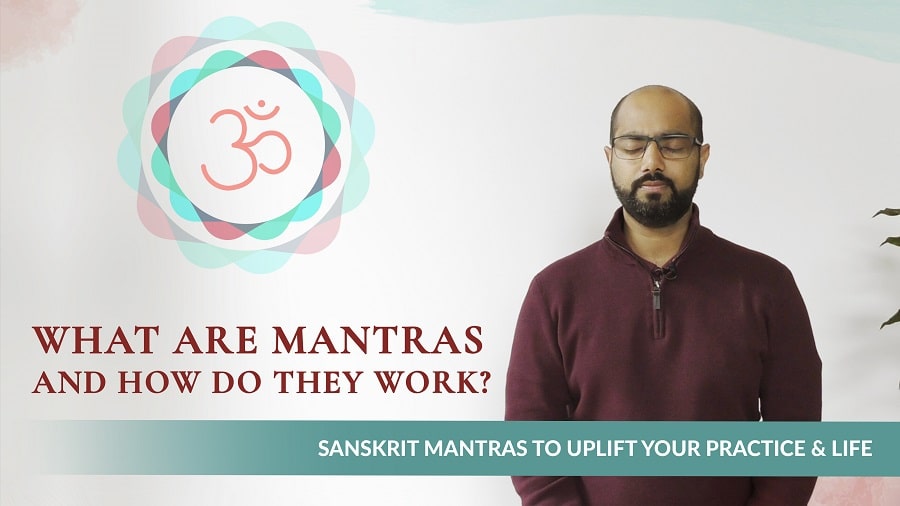Sound is an invaluable component of a yoga class. This is why a yoga class will typically begin and end with a sound or phrase that you may or may not know how to pronounce. In addition, you may or may not know the meaning. These words may be in Sanskrit or translated into English but you are chanting a mantra. To add meaning and benefit to the opening and closing of your time in a yoga class, read on further to find out about this sacred practice of chanting Sanskrit mantras!
What is a Mantra?
Sanskrit mantras have been an essential part of a holistic yoga practice. You may have experienced the power of mantras in your yoga class or a chanting session. The word mantra is comprised of two words man and tra. Man means the conscious and subconscious mind and tra means system. So mantras can be defined as a system to control or affect our conscious and subconscious mind. Mantras are made up of sounds that can be used to control the mind. Mantras can also be a word or phrase with a specific meaning attached to it, or without meaning.
What a Mantra is Not
It is common to find Sanskrit mantras on YouTube and Instagram. We are called upon to chant these mantras 9 or 108 times. We are prompted to chant these mantras with the promise of good health, wealth, protection, or good luck. It must be clearly stated that mantras have no inherent magical powers. Instead, chanting Sanskrit mantras with the right understanding can help one set an intention before practice and can be used to keep us in the present moment. It is critical to emphasize that the sound or phrase of mantras is meaningless on its own. Simply and mindlessly repeating mantras over and over again, will have no positive impact on you or your yoga practice.
Mantras and Yoga
The mind naturally wanders. Mantras act as a tool to reign in the mind, back to the present time and back to the intention of the practice. Mantras can control the mind by giving it direction and focus. When we chant a Sanskrit mantra and know the meaning of it, we are then able to steer the mind in a positive direction and keep it focused. This is why setting an intention before a yoga class is so helpful. If we have an intention, we have direction.
The Benefits of Mantras & Chanting
Mantras are in the Sanskrit language. As explained, mantras must be understood and pronounced correctly to have any meaningful impact. You can enjoy various benefits such as:
- Mantras help you stay focused in your practice.
- Mantras can bring calm to the mind.
- Mantras chanted as prescribed can emit feelings of gratitude, positivity.
- Mantras can help improve one’s mindset and welcome the wisdom of yoga philosophy into one’s belief system.
It is worthwhile to find a mantra that resonates with you and find the meaning of that mantra. Set your intention using the meaning of the mantra. For example, there is a mantra from the Krishna Yajurveda Taittiriya Upanishad that is recited before the scriptural study. Chanting it sets an intention for both Guru and disciple. You can then fully enjoy the benefits of chanting mantras.
Om Saha Naav-Avatu
Saha Nau Bhunaktu
Saha Viiryam Karavaavahai
Tejasvi Naav-Adhiitam-Astu Maa Vidvissaavahai
Om Shanti Shanti Shanti
Om, May we all be protected
May we all be nourished
May we work together with plenty of energy
May our intellect be sharpened, may our study be effective
Let there be no animosity amongst us
Om, peace (in me), peace (in nature), peace (in divine force)
Reciting this Sanskrit mantra with understanding and intention sets the tone for learning. It is an intention the Guru keeps in mind to return to why she is teaching. Throughout the process, the disciple keeps returning to why he is learning. This is the power of chanting a mantra with intention and understanding.

Discover yoga philosophy principles to boost your happiness
Get free access to a life-changing series of 6 webinars with Arhanta Yoga founder Ram Jain
Key Mantras for Yoga and Meditation
As a result, it is now clearer that for mantras to be useful, they must be pronounced correctly. To help with this, here are some tips to help you with pronunciation:
- Using the mouth and throat as an apparatus
- Using the above to develop the sound of the mantra clearly
- The sound of the mantra itself; each syllable
- Coordinate breath to the sound of the mantra
Aum
AUM stands for God or the highest form of divinity.
- In this mantra, there is an ‘n’ sound at the end as in “AAAUUUMMMNNN”
- Start with the “A” sound at the base of the throat, the larynx.
- The "U" sound uses the mouth and lips.
- The “M” uses the nasal cavity and for the “n” sound, imagine the sound being directed upwards toward the crown of the head.
Om
Om is the seed mantra of the Third Eye Chakra.
- The “O” sound comes from the mouth
- The “M” comes from the nasal cavity.
Om Shanti Shanti Shanti
At the end of a yoga class, you may hear “Shanti,” which means peace. We chant it three times to bring peace to the physical, astral, and spiritual bodies.
The Gayatri Mantra
This Sanskrit mantra is directed to Goddess Gayatri. The Sun is a divine symbol with a male and female side. Surya is the male side and Gayatri is the female side. We use this mantra to ask Goddess Gayatri for light in the darkness of our ignorance so that we may move to Truth.
Om bhūr bhuvaḥ suvaḥ
Tatsaviturvareṇyaṃ
Bhargo devasyadhīmahi
Dhiyo yo naḥ prachodayāt
Truth & Peace Mantra
This Sanskrit mantra is about dissolving one’s ignorance, darkness with the light of Self-Knowledge, and liberation from the birth-death cycle.
Asato Ma Sat Gamaya
Tamaso Ma Jyotir Gamaya
Mrityor Ma Amritam Gamaya
From illusion lead me to truth,
From darkness lead me to light,
From Death, lead me to Immortality.
May you find the right mantra for you and use it correctly in your yoga practice!
As you have surely found, sound is definitely an important aspect of your yoga practice. You can now try adding a mantra to the beginning and end of your yoga practice. Look up the meaning and give your mantra the power it deserves. Enjoy the benefits of mantras!
Are you ready to learn about another amazing yoga practice. You may have seen hands and fingers take an interesting shape or form during yoga practice or meditation. The likes of hands in prayer position before Surya Namaskar or connecting the thumb and index fingers of both hands in meditation? Well, these positions of the hands and fingers are sacred gestures called mudras. Like other practices in yoga, they have purpose and significance. Read on to find out more about mudras!

Discover yoga philosophy principles to boost your happiness
Get free access to a life-changing series of 6 webinars with Arhanta Yoga founder Ram Jain

